tow LINCOLN MKS 2016 Owners Manual
[x] Cancel search | Manufacturer: LINCOLN, Model Year: 2016, Model line: MKS, Model: LINCOLN MKS 2016Pages: 382, PDF Size: 3.81 MB
Page 5 of 382
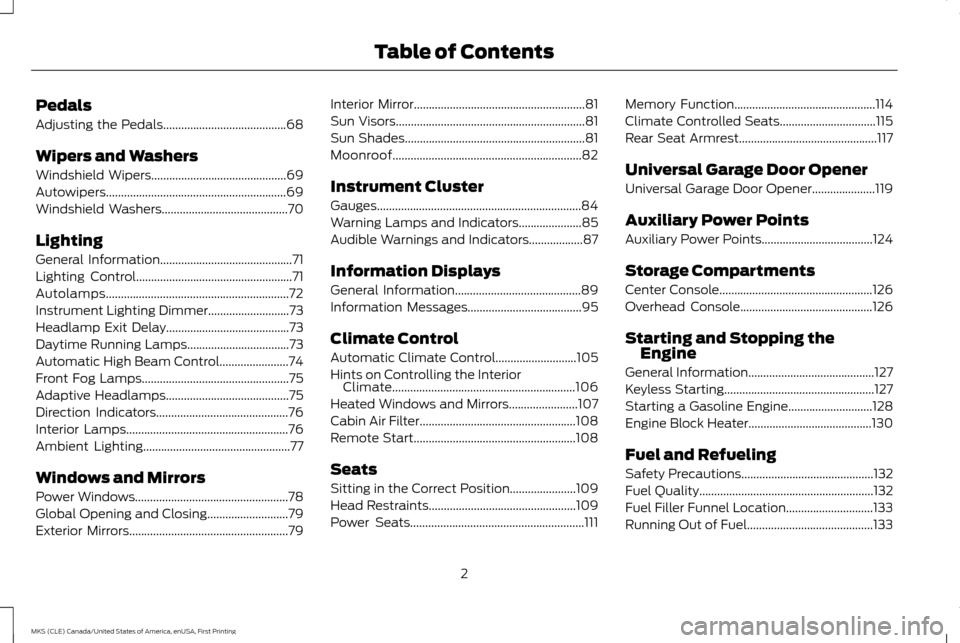
Pedals
Adjusting the Pedals.........................................68
Wipers and Washers
Windshield Wipers.............................................69
Autowipers............................................................69
Windshield Washers
..........................................70
Lighting
General Information
............................................71
Lighting Control
....................................................71
Autolamps.............................................................72
Instrument Lighting Dimmer...........................73
Headlamp Exit Delay.........................................73
Daytime Running Lamps..................................73
Automatic High Beam Control
.......................74
Front Fog Lamps.................................................75
Adaptive Headlamps.........................................75
Direction Indicators
............................................76
Interior Lamps
......................................................76
Ambient Lighting
.................................................77
Windows and Mirrors
Power Windows
...................................................78
Global Opening and Closing
...........................79
Exterior Mirrors.....................................................79 Interior Mirror
.........................................................81
Sun Visors
...............................................................81
Sun Shades
............................................................81
Moonroof...............................................................82
Instrument Cluster
Gauges....................................................................84
Warning Lamps and Indicators.....................85
Audible Warnings and Indicators..................87
Information Displays
General Information..........................................89
Information Messages
......................................95
Climate Control
Automatic Climate Control
...........................105
Hints on Controlling the Interior Climate.............................................................106
Heated Windows and Mirrors
.......................107
Cabin Air Filter....................................................108
Remote Start......................................................108
Seats
Sitting in the Correct Position......................109
Head Restraints
.................................................109
Power Seats..........................................................111 Memory Function
...............................................114
Climate Controlled Seats
................................115
Rear Seat Armrest..............................................117
Universal Garage Door Opener
Universal Garage Door Opener.....................119
Auxiliary Power Points
Auxiliary Power Points
.....................................124
Storage Compartments
Center Console
...................................................126
Overhead Console
............................................126
Starting and Stopping the Engine
General Information
..........................................127
Keyless Starting..................................................127
Starting a Gasoline Engine
............................128
Engine Block Heater.........................................130
Fuel and Refueling
Safety Precautions
............................................132
Fuel Quality
..........................................................132
Fuel Filler Funnel Location.............................133
Running Out of Fuel..........................................133
2
MKS (CLE) Canada/United States of America, enUSA, First Printing Table of Contents
Page 6 of 382
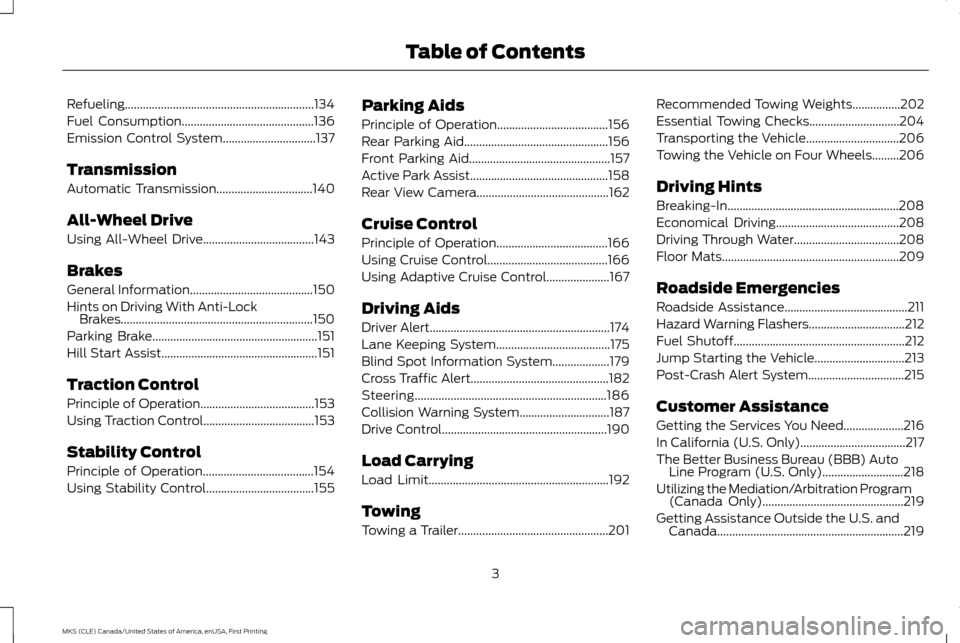
Refueling...............................................................134
Fuel Consumption............................................136
Emission Control System...............................137
Transmission
Automatic Transmission
................................140
All-Wheel Drive
Using All-Wheel Drive.....................................143
Brakes
General Information
.........................................150
Hints on Driving With Anti-Lock Brakes................................................................150
Parking Brake
.......................................................151
Hill Start Assist
....................................................151
Traction Control
Principle of Operation......................................153
Using Traction Control
.....................................153
Stability Control
Principle of Operation.....................................154
Using Stability Control....................................155 Parking Aids
Principle of Operation.....................................156
Rear Parking Aid................................................156
Front Parking Aid
...............................................157
Active Park Assist..............................................158
Rear View Camera
............................................162
Cruise Control
Principle of Operation
.....................................166
Using Cruise Control........................................166
Using Adaptive Cruise Control.....................167
Driving Aids
Driver Alert
............................................................174
Lane Keeping System......................................175
Blind Spot Information System
...................179
Cross Traffic Alert..............................................182
Steering................................................................186
Collision Warning System..............................187
Drive Control
.......................................................190
Load Carrying
Load Limit............................................................192
Towing
Towing a Trailer
..................................................201 Recommended Towing Weights................202
Essential Towing Checks..............................204
Transporting the Vehicle...............................206
Towing the Vehicle on Four Wheels.........206
Driving Hints
Breaking-In.........................................................208
Economical Driving
.........................................208
Driving Through Water...................................208
Floor Mats
...........................................................209
Roadside Emergencies
Roadside Assistance
.........................................211
Hazard Warning Flashers................................212
Fuel Shutoff
.........................................................212
Jump Starting the Vehicle..............................213
Post-Crash Alert System................................215
Customer Assistance
Getting the Services You Need....................216
In California (U.S. Only)...................................217
The Better Business Bureau (BBB) Auto Line Program (U.S. Only)...........................218
Utilizing the Mediation/Arbitration Program (Canada Only)
...............................................219
Getting Assistance Outside the U.S. and Canada..............................................................219
3
MKS (CLE) Canada/United States of America, enUSA, First Printing Table of Contents
Page 10 of 382
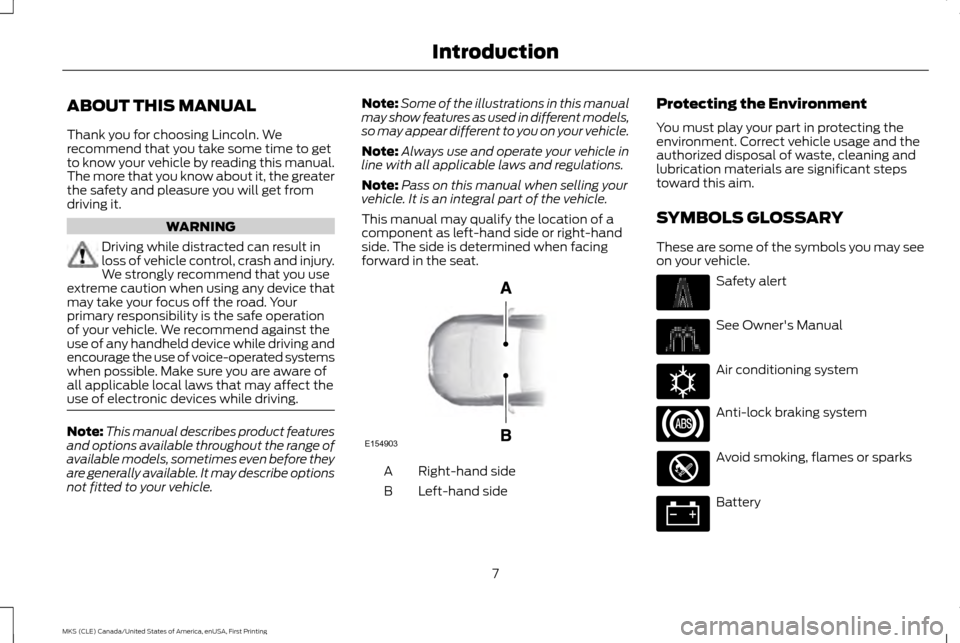
ABOUT THIS MANUAL
Thank you for choosing Lincoln. We
recommend that you take some time to get
to know your vehicle by reading this manual.
The more that you know about it, the greater
the safety and pleasure you will get from
driving it.
WARNING
Driving while distracted can result in
loss of vehicle control, crash and injury.
We strongly recommend that you use
extreme caution when using any device that
may take your focus off the road. Your
primary responsibility is the safe operation
of your vehicle. We recommend against the
use of any handheld device while driving and
encourage the use of voice-operated systems
when possible. Make sure you are aware of
all applicable local laws that may affect the
use of electronic devices while driving. Note:
This manual describes product features
and options available throughout the range of
available models, sometimes even before they
are generally available. It may describe options
not fitted to your vehicle. Note:
Some of the illustrations in this manual
may show features as used in different models,
so may appear different to you on your vehicle.
Note: Always use and operate your vehicle in
line with all applicable laws and regulations.
Note: Pass on this manual when selling your
vehicle. It is an integral part of the vehicle.
This manual may qualify the location of a
component as left-hand side or right-hand
side. The side is determined when facing
forward in the seat. Right-hand side
A
Left-hand side
B Protecting the Environment
You must play your part in protecting the
environment. Correct vehicle usage and the
authorized disposal of waste, cleaning and
lubrication materials are significant steps
toward this aim.
SYMBOLS GLOSSARY
These are some of the symbols you may see
on your vehicle.
Safety alert
See Owner's Manual
Air conditioning system
Anti-lock braking system
Avoid smoking, flames or sparks
Battery
7
MKS (CLE) Canada/United States of America, enUSA, First Printing IntroductionE154903 E162384
Page 17 of 382

PROTECTING THE
ENVIRONMENT
You must play your part in protecting the
environment. Correct vehicle usage and the
authorized disposal of waste, cleaning and
lubrication materials are significant steps
toward this aim.
14
MKS (CLE) Canada/United States of America, enUSA, First Printing Environment
Page 22 of 382
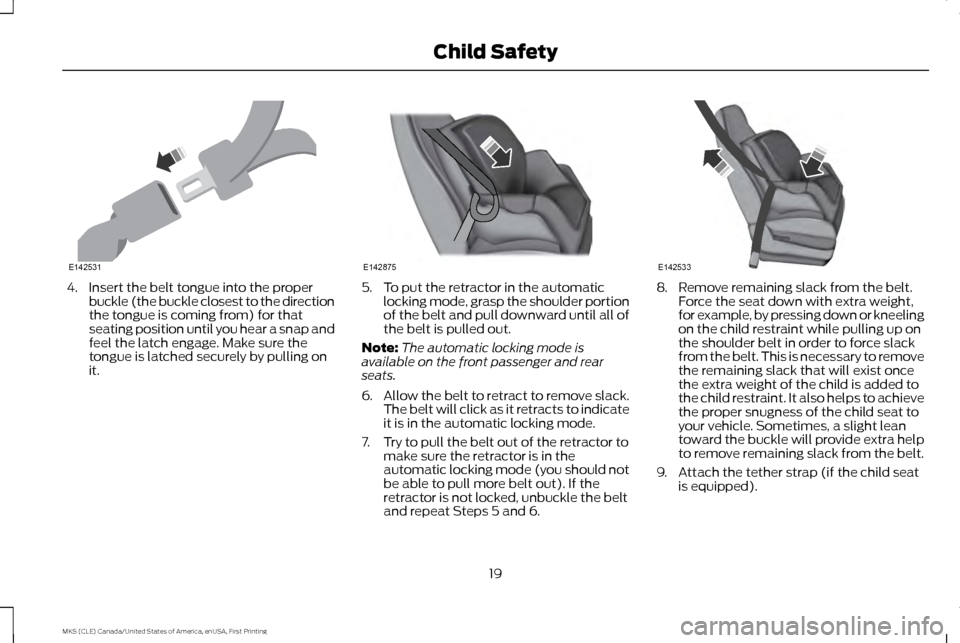
4. Insert the belt tongue into the proper
buckle (the buckle closest to the direction
the tongue is coming from) for that
seating position until you hear a snap and
feel the latch engage. Make sure the
tongue is latched securely by pulling on
it. 5. To put the retractor in the automatic
locking mode, grasp the shoulder portion
of the belt and pull downward until all of
the belt is pulled out.
Note: The automatic locking mode is
available on the front passenger and rear
seats.
6. Allow the belt to retract to remove slack.
The belt will click as it retracts to indicate
it is in the automatic locking mode.
7. Try to pull the belt out of the retractor to make sure the retractor is in the
automatic locking mode (you should not
be able to pull more belt out). If the
retractor is not locked, unbuckle the belt
and repeat Steps 5 and 6. 8. Remove remaining slack from the belt.
Force the seat down with extra weight,
for example, by pressing down or kneeling
on the child restraint while pulling up on
the shoulder belt in order to force slack
from the belt. This is necessary to remove
the remaining slack that will exist once
the extra weight of the child is added to
the child restraint. It also helps to achieve
the proper snugness of the child seat to
your vehicle. Sometimes, a slight lean
toward the buckle will provide extra help
to remove remaining slack from the belt.
9. Attach the tether strap (if the child seat is equipped).
19
MKS (CLE) Canada/United States of America, enUSA, First Printing Child SafetyE142531 E142875 E142533
Page 29 of 382
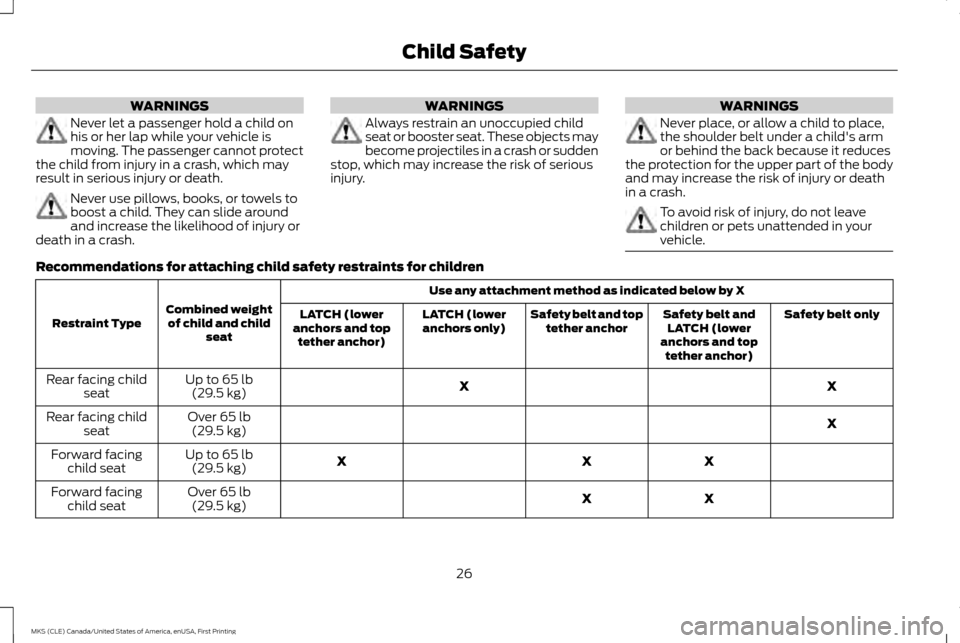
WARNINGS
Never let a passenger hold a child on
his or her lap while your vehicle is
moving. The passenger cannot protect
the child from injury in a crash, which may
result in serious injury or death. Never use pillows, books, or towels to
boost a child. They can slide around
and increase the likelihood of injury or
death in a crash. WARNINGS
Always restrain an unoccupied child
seat or booster seat. These objects may
become projectiles in a crash or sudden
stop, which may increase the risk of serious
injury. WARNINGS
Never place, or allow a child to place,
the shoulder belt under a child's arm
or behind the back because it reduces
the protection for the upper part of the body
and may increase the risk of injury or death
in a crash. To avoid risk of injury, do not leave
children or pets unattended in your
vehicle.
Recommendations for attaching child safety restraints for children
Use any attachment method as indicated below by X
Combined weight of child and child seat
Restraint Type
Safety belt only
Safety belt and
LATCH (lower
anchors and top tether anchor)
Safety belt and top
tether anchor
LATCH (lower
anchors only)
LATCH (lower
anchors and top tether anchor)
X
X
Up to 65 lb
(29.5 kg)
Rear facing child
seat
X
Over
65 lb
(29.5 kg)
Rear facing child
seat
X
X
X
Up to
65 lb
(29.5 kg)
Forward facing
child seat
X
X
Over
65 lb
(29.5 kg)
Forward facing
child seat
26
MKS (CLE) Canada/United States of America, enUSA, First Printing Child Safety
Page 47 of 382
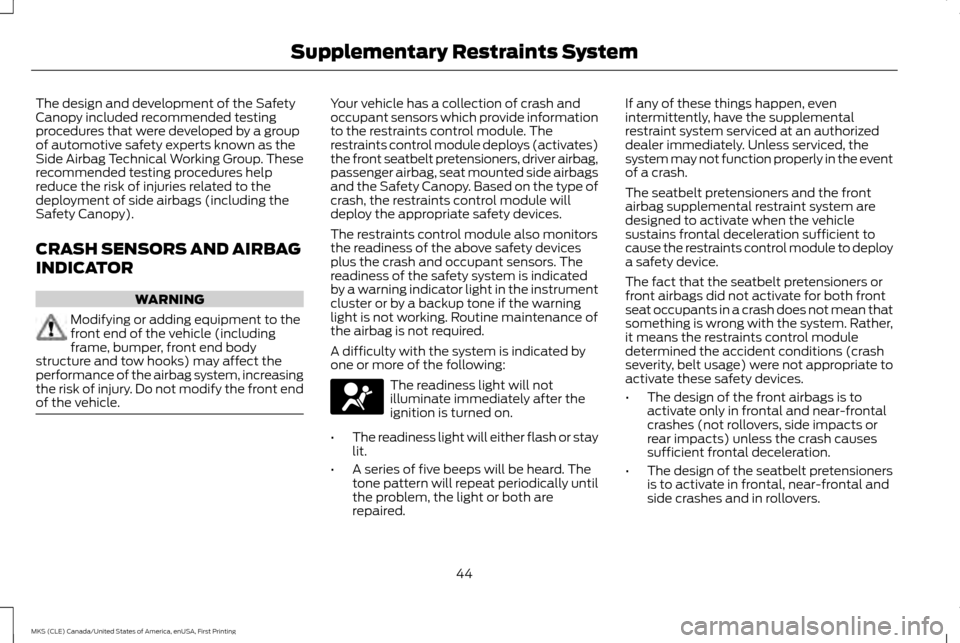
The design and development of the Safety
Canopy included recommended testing
procedures that were developed by a group
of automotive safety experts known as the
Side Airbag Technical Working Group. These
recommended testing procedures help
reduce the risk of injuries related to the
deployment of side airbags (including the
Safety Canopy).
CRASH SENSORS AND AIRBAG
INDICATOR
WARNING
Modifying or adding equipment to the
front end of the vehicle (including
frame, bumper, front end body
structure and tow hooks) may affect the
performance of the airbag system, increasing
the risk of injury. Do not modify the front end
of the vehicle. Your vehicle has a collection of crash and
occupant sensors which provide information
to the restraints control module. The
restraints control module deploys (activates)
the front seatbelt pretensioners, driver airbag,
passenger airbag, seat mounted side airbags
and the Safety Canopy. Based on the type of
crash, the restraints control module will
deploy the appropriate safety devices.
The restraints control module also monitors
the readiness of the above safety devices
plus the crash and occupant sensors. The
readiness of the safety system is indicated
by a warning indicator light in the instrument
cluster or by a backup tone if the warning
light is not working. Routine maintenance of
the airbag is not required.
A difficulty with the system is indicated by
one or more of the following:
The readiness light will not
illuminate immediately after the
ignition is turned on.
• The readiness light will either flash or stay
lit.
• A series of five beeps will be heard. The
tone pattern will repeat periodically until
the problem, the light or both are
repaired. If any of these things happen, even
intermittently, have the supplemental
restraint system serviced at an authorized
dealer immediately. Unless serviced, the
system may not function properly in the event
of a crash.
The seatbelt pretensioners and the front
airbag supplemental restraint system are
designed to activate when the vehicle
sustains frontal deceleration sufficient to
cause the restraints control module to deploy
a safety device.
The fact that the seatbelt pretensioners or
front airbags did not activate for both front
seat occupants in a crash does not mean that
something is wrong with the system. Rather,
it means the restraints control module
determined the accident conditions (crash
severity, belt usage) were not appropriate to
activate these safety devices.
•
The design of the front airbags is to
activate only in frontal and near-frontal
crashes (not rollovers, side impacts or
rear impacts) unless the crash causes
sufficient frontal deceleration.
• The design of the seatbelt pretensioners
is to activate in frontal, near-frontal and
side crashes and in rollovers.
44
MKS (CLE) Canada/United States of America, enUSA, First Printing Supplementary Restraints System
Page 49 of 382

GENERAL INFORMATION ON
RADIO FREQUENCIES
This device complies with Part 15 of the FCC
Rules and with Industry Canada
license-exempt RSS standard(s). Operation
is subject to the following two conditions: (1)
This device may not cause harmful
interference, and (2) This device must accept
any interference received, including
interference that may cause undesired
operation.
Note:
Changes or modifications not
expressively approved by the party responsible
for compliance could void the user's authority
to operate the equipment. The term IC before
the radio certification number only signifies
that Industry Canada technical specifications
were met.
The typical operating range for your
transmitter is approximately 33 feet (10
meters). Vehicles with the remote start
feature will have a greater range. One of the
following could cause a decrease in operating
range:
• weather conditions
• nearby radio towers
• structures around the vehicle
• other vehicles parked next to your vehicle Other short-distance radio transmitters, such
as amateur radios, medical equipment,
wireless headphones, remote controls and
alarm systems may operate on the same
frequency as your remote control. If other
transmitters are operating on those
frequencies, you may not be able to use your
remote control. Using your remote control
near some types of electronic equipment,
such as USB devices, computers or cell
phones can interfere with remote operation.
Operating your remote control near metal or
metallic-finished purses, bags or clothing can
interfere with remote operation. You can lock
and unlock the doors with the key.
Note:
Make sure to lock your vehicle before
leaving it unattended.
Note: If you are in range, the remote control
will operate if you press any button
unintentionally. Intelligent Access
The system uses a radio frequency signal to
communicate with your vehicle and authorize
your vehicle to unlock when one of the
following conditions are met:
•
You touch the inside of any exterior door
handle within 3 ft (1 m) proximity of an
intelligent access key.
• You press the luggage compartment
button.
• You press a button on the transmitter.
If excessive radio frequency interference is
present in the area or if the transmitter
battery is low, you may need to mechanically
unlock your door. You can use the mechanical
key blade in your intelligent access key to
open the driver door in this situation. See
Remote Control
(page 47).
46
MKS (CLE) Canada/United States of America, enUSA, First Printing Keys and Remote Controls
Page 64 of 382

To display the factory-set five-digit code in
the information display:
1. Place the first programmed key in the
backup slot inside the glove
compartment. The key ring must be at
the top with the buttons facing toward
the rear.
2. Press the START/STOP button once
and wait a few seconds.
3. Press the
START/STOP button again
and remove the key.
4. Insert the second programmed key into the backup slot, then press the
START/STOP
button.
The factory-set five-digit code will appear in
the information display for a few seconds. Note:
The code may not display until after
any other warning messages first display.
INTERIOR LUGGAGE
COMPARTMENT RELEASE WARNINGS
Keep vehicle doors and luggage
compartment locked and keep keys
and remote transmitters out of a child
’s
reach. Unsupervised children could lock
themselves in the trunk and risk injury.
Children should be taught not to play in
vehicles. Do not leave children or animals
unattended in the vehicle. On hot days,
the temperature in the luggage
compartment or vehicle interior can rise very
quickly. Exposure of people or animals to
these high temperatures for even a short time
can cause death or serious heat-related
injuries, including brain damage. Small
children are particularly at risk. Your vehicle is equipped with a release
handle that provides a means of escape for
children and adults if they become locked
inside the luggage compartment.Adults should familiarize themselves with
the operation and location of the release
handle.
61
MKS (CLE) Canada/United States of America, enUSA, First Printing LocksE173591 E144403
Page 66 of 382

PASSIVE ANTI-THEFT SYSTEM
Note:
The system is not compatible with
non-Ford aftermarket remote start systems.
Use of these systems may result in vehicle
starting problems and a loss of security
protection.
Note: Metallic objects, electronic devices or
a second coded key on the same key chain
may cause vehicle starting problems if they
are too close to the key when starting your
vehicle. Prevent these objects from touching
the coded key while starting your vehicle.
Switch the ignition off, move all objects on the
key chain away from the coded key and restart
your vehicle if a problem occurs.
Note: Do not leave a duplicate coded key in
your vehicle. Always take your keys and lock
all doors when leaving your vehicle. The
system is an engine immobilization system. It
will not start without a coded key programmed
to your vehicle. If you use the wrong key, a
message may appear in the information
display. SecuriLock
The system helps prevent your vehicle from
starting unless you use a coded key
programmed to your vehicle. Using the wrong
key may prevent your vehicle from starting.
A message may appear in the information
display.
If you are unable to start your vehicle with a
correctly coded key, it is not operating
properly. A message may appear in the
information display.
Automatic Arming
Your vehicle arms immediately after
switching the ignition off.
Automatic Disarming
Switching the ignition on with a coded key
disarms your vehicle.
Replacement Keys
Note:
Your vehicle comes equipped with two
intelligent access keys.
The intelligent access key functions as a
programmed key that operates the driver
door lock and activates the intelligent access
with push button start system, as well as a
remote control. If your programmed transmitters are lost or
stolen and you do not have an extra coded
key, you will need to have your vehicle towed
to an authorized dealer. You need to erase
the key codes from your vehicle and program
new coded keys.
Store an extra programmed key away from
your vehicle in a safe place to help prevent
any inconveniences. Contact your authorized
dealer to purchase additional spare or
replacement keys.
Programming a Spare Intelligent Access
Key
Note:
You can program a maximum of four
intelligent access keys to your vehicle.
You must have two previously programmed
intelligent access keys inside your vehicle and
the new unprogrammed intelligent access
keys readily accessible. Contact an
authorized dealer to have the spare key
programmed if two previously programmed
keys are not available.
63
MKS (CLE) Canada/United States of America, enUSA, First Printing Security